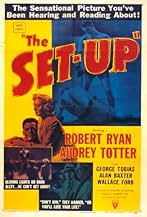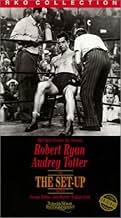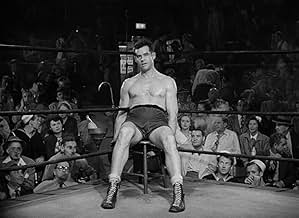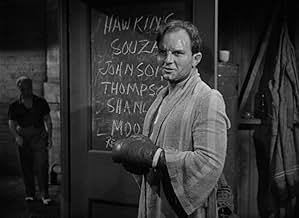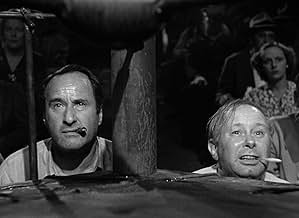PUNTUACIÓN EN IMDb
7,8/10
11 mil
TU PUNTUACIÓN
Esperando la habitual derrota, un manager de boxeo acepta sobornos de un gánster de las apuestas sin decírselo a su púgil.Esperando la habitual derrota, un manager de boxeo acepta sobornos de un gánster de las apuestas sin decírselo a su púgil.Esperando la habitual derrota, un manager de boxeo acepta sobornos de un gánster de las apuestas sin decírselo a su púgil.
- Dirección
- Guión
- Reparto principal
- Nominado a 1 premio BAFTA
- 2 premios y 2 nominaciones en total
Hal Baylor
- Tiger Nelson
- (as Hal Fieberling)
Kevin O'Morrison
- Moore
- (as Kenny O'Morrison)
Herbert Anderson
- Husband
- (sin acreditar)
Larry Anzalone
- Mexican Fighter
- (sin acreditar)
Arthur Berkeley
- Cafe Patron
- (sin acreditar)
Phil Bloom
- Minor Role
- (sin acreditar)
Burman Bodel
- Man
- (sin acreditar)
Reseñas destacadas
If your taste runs to happy endings and beautiful people than stay away from The Set-Up. But if gritty and realistic drama is your taste you can't do better than this noir classic about the world of boxing. The Set-Up anticipated Rod Serling's Requiem For a Heavyweight by a decade as it deals with the same issues about a boxer at the end of his career.
Anthony Quinn might very well have seen Robert Ryan in The Set-Up when he played Mountain Rivera in Requiem For A Heavyweight. Rod Serling must have seen it as well. Both films deal with a boxer at the end of his career, but who has a lot of pride. Manager George Tobias and trainer Percy Helton get an offer from gambler Alan Baxter who is backing an up and coming heavyweight contender Hal Baylor. Ryan is just another step up the ladder, a ladder when Ryan was younger he was climbing. Tobias and Helton agree to take a dive, but no one can broach the subject to Ryan.
Which sets it all up for the final match and the aftermath where Ryan betrayed by all hangs in on nerve and pride alone. What happens afterward is for you to view, but don't expect the same kind of resolution that Requiem For A Heavyweight gave.
A really big surprise here are George Tobias and Percy Helton who normally play comic parts are quite serious here as a pair of fight game characters. The performances are so atypical of the work you've come to expect from both.
Ryan's amateur boxing career no doubt stood him in good stead for this role. He makes a rugged looking boxer who's been through the ring wars over and over again. That helps him in this latest encounter.
The sets are gritty and realistic, in fact I've never seen an urban area done so well until Otto Preminger's The Man With The Golden Arm debuted six years later. Preminger also might have been influenced by The Set-Up when he made his classic.
Although unnoticed at first, The Set-Up has slowly built a reputation as one of the great noir films out of RKO and one of the best boxing films ever made. For myself it certainly influenced a lot of people.
Anthony Quinn might very well have seen Robert Ryan in The Set-Up when he played Mountain Rivera in Requiem For A Heavyweight. Rod Serling must have seen it as well. Both films deal with a boxer at the end of his career, but who has a lot of pride. Manager George Tobias and trainer Percy Helton get an offer from gambler Alan Baxter who is backing an up and coming heavyweight contender Hal Baylor. Ryan is just another step up the ladder, a ladder when Ryan was younger he was climbing. Tobias and Helton agree to take a dive, but no one can broach the subject to Ryan.
Which sets it all up for the final match and the aftermath where Ryan betrayed by all hangs in on nerve and pride alone. What happens afterward is for you to view, but don't expect the same kind of resolution that Requiem For A Heavyweight gave.
A really big surprise here are George Tobias and Percy Helton who normally play comic parts are quite serious here as a pair of fight game characters. The performances are so atypical of the work you've come to expect from both.
Ryan's amateur boxing career no doubt stood him in good stead for this role. He makes a rugged looking boxer who's been through the ring wars over and over again. That helps him in this latest encounter.
The sets are gritty and realistic, in fact I've never seen an urban area done so well until Otto Preminger's The Man With The Golden Arm debuted six years later. Preminger also might have been influenced by The Set-Up when he made his classic.
Although unnoticed at first, The Set-Up has slowly built a reputation as one of the great noir films out of RKO and one of the best boxing films ever made. For myself it certainly influenced a lot of people.
The Set-Up (1949)
This might be the best boxing movie ever made. It's kind of the opposite of "Rocky," of course (this one is about the small points, and not about becoming champion). But it's also the opposite of the two other classics that come to mind: "Raging Bull" and "Body and Soul."
Director Robert Wise made sure that everything here felt authentic and gritty--almost too authentic and gritty. You marvel at all the types in the crowds, inside and outside the ring. You notice the small rooms, the ordinary props, the lack of glamour. If you aren't afraid of the word mise-en-scene, this has created it perfectly. It's transporting.
And moving. Robert Ryan in the lead pulls out some of his best, subtle reactions. He's sometimes prone to strained expressions that may not always fit his character, but here he is thoughtful and determined and showing signs of being the old wise man in the crowd as the younger boxers act cocky or scared.
Then there's the plot drawn out of the title. It's a good thing this doesn't dominate the movie, at least not until the end, because the real plot has to do with a man coming to grips with the end of his career. And with a woman who loves him truly. It's great stuff.
This might be the best boxing movie ever made. It's kind of the opposite of "Rocky," of course (this one is about the small points, and not about becoming champion). But it's also the opposite of the two other classics that come to mind: "Raging Bull" and "Body and Soul."
Director Robert Wise made sure that everything here felt authentic and gritty--almost too authentic and gritty. You marvel at all the types in the crowds, inside and outside the ring. You notice the small rooms, the ordinary props, the lack of glamour. If you aren't afraid of the word mise-en-scene, this has created it perfectly. It's transporting.
And moving. Robert Ryan in the lead pulls out some of his best, subtle reactions. He's sometimes prone to strained expressions that may not always fit his character, but here he is thoughtful and determined and showing signs of being the old wise man in the crowd as the younger boxers act cocky or scared.
Then there's the plot drawn out of the title. It's a good thing this doesn't dominate the movie, at least not until the end, because the real plot has to do with a man coming to grips with the end of his career. And with a woman who loves him truly. It's great stuff.
Robert Ryan is a victim of "The Set-Up" in this 1949 film also starring Audrey Totter, George Tobias and Percy Helton. Ryan plays Stoker Thompson, a 35-year-old prize fighter who is still trying to make it. Totter is his wife, who wants him to quit before he's crippled and/or brain-damaged. In fact, she's not even sure she can watch him fight anymore, though he begs her to come to the arena. What he doesn't know is that his handlers have accepted money for him to take a fall. They don't bother telling him because they believe he's going to lose anyway.
Hollywood has long had a love affair with the fight business. It's easy to see why - it's a visual sport and one-on-one, and there's always a story to tell, either about a loser or an egomaniacal winner. "The Set-Up" is a fascinating film brilliantly directed by Robert Wise, with the boxing match done in real time. The action switches back and forth from the arena to Stoker's wife walking through the dark city trying to sort out her feelings and ultimately ripping up her ticket to the match. Meanwhile, Stoker keeps looking out the window at his apartment window - when he sees that the lights are off, he believes she's coming to the fight.
The fight itself is incredibly realistic and brutal, and the focus is on what can only be described as sadists sitting around the ring yelling, truly man at his most barbaric in Wise's approach. The entire experience - the fight and the audience reactions - is very uncomfortable. The match is difficult enough to watch, but the aftermath is worse for the tension factor alone. Interestingly, Wise lets us see the violence in the ring and let's us imagine some of the violence outside of it later.
For a time in his career, Robert Ryan had kind of a gentle giant thing going occasionally. A very prolific actor, he could be pathetic, as he is here, or take on a character with mental or emotional problems with ease. As his career continued, he played increasingly more angry and violent men. Toward the end of his career, however, he portrayed John the Baptist and Nolan in "The Man Without a Country." He's terrific here as a sad, desperate man going for the glory when he's just about washed up; he is in a business with no humanity, yet he sticks out because he is kind and reeks of goodness. Audrey Totter is very good as his wife, who loves him and wants more for him than being beaten up. Tobias and Helton give great performances as men whose souls left them a long time ago. The rest of the cast is equally good.
This film makes a profound impression on the viewer, and if you're not interested in fighting, you definitely won't be after this film. If you're a fan of the sport, you'll perhaps ask yourself why. No matter what, you won't be unaffected.
Hollywood has long had a love affair with the fight business. It's easy to see why - it's a visual sport and one-on-one, and there's always a story to tell, either about a loser or an egomaniacal winner. "The Set-Up" is a fascinating film brilliantly directed by Robert Wise, with the boxing match done in real time. The action switches back and forth from the arena to Stoker's wife walking through the dark city trying to sort out her feelings and ultimately ripping up her ticket to the match. Meanwhile, Stoker keeps looking out the window at his apartment window - when he sees that the lights are off, he believes she's coming to the fight.
The fight itself is incredibly realistic and brutal, and the focus is on what can only be described as sadists sitting around the ring yelling, truly man at his most barbaric in Wise's approach. The entire experience - the fight and the audience reactions - is very uncomfortable. The match is difficult enough to watch, but the aftermath is worse for the tension factor alone. Interestingly, Wise lets us see the violence in the ring and let's us imagine some of the violence outside of it later.
For a time in his career, Robert Ryan had kind of a gentle giant thing going occasionally. A very prolific actor, he could be pathetic, as he is here, or take on a character with mental or emotional problems with ease. As his career continued, he played increasingly more angry and violent men. Toward the end of his career, however, he portrayed John the Baptist and Nolan in "The Man Without a Country." He's terrific here as a sad, desperate man going for the glory when he's just about washed up; he is in a business with no humanity, yet he sticks out because he is kind and reeks of goodness. Audrey Totter is very good as his wife, who loves him and wants more for him than being beaten up. Tobias and Helton give great performances as men whose souls left them a long time ago. The rest of the cast is equally good.
This film makes a profound impression on the viewer, and if you're not interested in fighting, you definitely won't be after this film. If you're a fan of the sport, you'll perhaps ask yourself why. No matter what, you won't be unaffected.
This is an awfully hard and brutal movie, produced at the end of the brief, rather high end Dore Schary regime at RKO (1946-48), just prior to Howard Hughes' purchase of the studio, which led to the company's slow, agonizing decline that forced it, or rather its new owners, to close it down ten years later. It's the story of an aging boxer, over the hill but still harboring a measure of optimism, really a sort of pride. In this tragic role Robert Ryan is superb. Tough, compassionate, deeply ethical, realistic, and yet with just enough of the dreamer in him to keep him emotionally afloat, Stoker Thompson represents the best qualities of the so-called common man. In an earlier, more heroic age, he might have been a knight; but alas we do not live in such a time, thus his personal qualities go unnoticed by all but his wife. In this role, Audrey Totter is almost as good as Ryan. Some of her scenes are unforgettable, as when she tears up the ticket to her husband's fight and throws it over the bridge into the steam of an oncoming train; or when she watches a bunch of silly teenagers "play" at boxing with a couple of performing puppets, which at first amuses her, then horrify her when she realizes her own and her husband's fate in this little "play" scene.
The film is a masterpiece of design and composition. Director Robert Wise never made a better picture than this. The movie, like High Noon, plays out in real time, and as a result has an air of urgency to it. Adapted from a poem by Joseph Moncure March, which tells essentially the same story, but with the main character a black man, Wise and scenarist Art Cohn take considerable liberties here that purists' might not care for. In the poem the setting is New York, while in the movie it's a tank town called Paradise City, a far cry from New York even if it's in fact less than a hundred miles away, upstate, or in New Jersey or Pennsylvania. The film never makes this clear. Here and there hints are dropped that the setting might be California. It doesn't matter. The Paradise City boxing arena is a place for young guys on their way up and old guys on their way down. It's a million miles from Madison Square Garden, and that's all that counts.
The film's settings are beautifully realized; and Milton Krasner's photography is no less brilliant. The central street, all blinking lights, and yet shadowy and black in odd places, is a perfect visual metaphor for the action of the film; while seldom have the denizens of a small city looked more menacing. Men in garish ties and fedoras jostle each other on the sidewalk as they pass by. They are a hard, apathetic breed, and hungry for sensation. Inside the arena we see humanity at its least admirable, as there is an undercurrent of sadism in even the most innocuous-seeming fight fans, such as a blind man ("go for his eyes!). We sense that these people come not so much to see a favorite boxer win as a hapless boxer lose.
In the center of all this is Stoker, a man with character surrounded by people who couldn't care less. As his handlers, a porcine, toothpick-chewing Percy Helton, and a thick-witted George Tobias, are superb. In a somewhat smaller role, Edwin Max, in pinstripe suit, with pencil-line mustache's, and what look like three soggy Salada tea bags under each eye, is visually perfect as a small-time something, not even hood, just a guy who runs around and does things for the big guy, played by Alan Baxter, a sort of anti-Stoker, a man without qualities who goes to great lengths to show that he has class and principles, when in fact he has neither. The man is a monster, and he doesn't even have guts. When Stoker punches him in the face he lets his goons do the dirty work.
The interior lives of the two main characters in this film suggest an affinity with the humanistic stoicism Hemingway, while the surface is closer to Weegee and Walker Evans. Overall, though, the movie is pure RKO; its courage-in-the-face-of-adversity theme suggests, almost uncannily, this odd man out among the major studios' history and future, and the best qualities of those who worked there.
The film is a masterpiece of design and composition. Director Robert Wise never made a better picture than this. The movie, like High Noon, plays out in real time, and as a result has an air of urgency to it. Adapted from a poem by Joseph Moncure March, which tells essentially the same story, but with the main character a black man, Wise and scenarist Art Cohn take considerable liberties here that purists' might not care for. In the poem the setting is New York, while in the movie it's a tank town called Paradise City, a far cry from New York even if it's in fact less than a hundred miles away, upstate, or in New Jersey or Pennsylvania. The film never makes this clear. Here and there hints are dropped that the setting might be California. It doesn't matter. The Paradise City boxing arena is a place for young guys on their way up and old guys on their way down. It's a million miles from Madison Square Garden, and that's all that counts.
The film's settings are beautifully realized; and Milton Krasner's photography is no less brilliant. The central street, all blinking lights, and yet shadowy and black in odd places, is a perfect visual metaphor for the action of the film; while seldom have the denizens of a small city looked more menacing. Men in garish ties and fedoras jostle each other on the sidewalk as they pass by. They are a hard, apathetic breed, and hungry for sensation. Inside the arena we see humanity at its least admirable, as there is an undercurrent of sadism in even the most innocuous-seeming fight fans, such as a blind man ("go for his eyes!). We sense that these people come not so much to see a favorite boxer win as a hapless boxer lose.
In the center of all this is Stoker, a man with character surrounded by people who couldn't care less. As his handlers, a porcine, toothpick-chewing Percy Helton, and a thick-witted George Tobias, are superb. In a somewhat smaller role, Edwin Max, in pinstripe suit, with pencil-line mustache's, and what look like three soggy Salada tea bags under each eye, is visually perfect as a small-time something, not even hood, just a guy who runs around and does things for the big guy, played by Alan Baxter, a sort of anti-Stoker, a man without qualities who goes to great lengths to show that he has class and principles, when in fact he has neither. The man is a monster, and he doesn't even have guts. When Stoker punches him in the face he lets his goons do the dirty work.
The interior lives of the two main characters in this film suggest an affinity with the humanistic stoicism Hemingway, while the surface is closer to Weegee and Walker Evans. Overall, though, the movie is pure RKO; its courage-in-the-face-of-adversity theme suggests, almost uncannily, this odd man out among the major studios' history and future, and the best qualities of those who worked there.
More than a movie, this is an urban nightmare with an atmosphere thick enough to drown in. It's a vision of some never, never land of unending shadows, cheap neons, and snaking lines. Delirious pleasure seekers crowd "Dreamland" and the "Fun Arcade" or slip into the burger joint for a greasy slab, while overhead a band blares out a feverish tune. Soon the delirium spreads out into the dark as far as far as the eye can see. And through it all, weaves the camera, in and out, as though we too are trapped in the urban inferno.
Except the real pleasure-seekers crowd around a cone of shrunken light. Beneath the bulb, endless rounds of sweaty hopefuls beat out their brains for a few bucks and the roar of blood-lust delight. There's the fat guy stuffing his mouth with each hammer blow, the timid housewife shrieking along in ecstatic release, and the office guy shadow-boxing with the boss's kisser. And in the snake pit's center, there's an old guy, beaten and bloodied, trying to salvage some dignity before he checks out for the last time. Likely, he's the only one who cares. Yeah, it's a great little movie, maybe the best ever on boxing-- with an iconic Robert Ryan, an over-scrubbed Audrey Totter, and a reptilian Alan Baxter. Don't miss it.
Except the real pleasure-seekers crowd around a cone of shrunken light. Beneath the bulb, endless rounds of sweaty hopefuls beat out their brains for a few bucks and the roar of blood-lust delight. There's the fat guy stuffing his mouth with each hammer blow, the timid housewife shrieking along in ecstatic release, and the office guy shadow-boxing with the boss's kisser. And in the snake pit's center, there's an old guy, beaten and bloodied, trying to salvage some dignity before he checks out for the last time. Likely, he's the only one who cares. Yeah, it's a great little movie, maybe the best ever on boxing-- with an iconic Robert Ryan, an over-scrubbed Audrey Totter, and a reptilian Alan Baxter. Don't miss it.
¿Sabías que...?
- CuriosidadesThe clock on the square at the beginning shows 9:05 PM, and the same clock at the end shows 10:16 PM. The movie takes place in real time.
- PifiasAfter the big fight, when Stoker is in the locker room, he opens his locker and takes out his clothes and shoes. In two subsequent shots his shoes are back in the locker, and then in a fourth shot he removes his shoes from the locker a second time.
- ConexionesFeatured in Film Review: Robert Wise (1967)
Selecciones populares
Inicia sesión para calificar y añadir a tu lista para recibir recomendaciones personalizadas
- How long is The Set-Up?Con tecnología de Alexa
Detalles
- Fecha de lanzamiento
- País de origen
- Idioma
- Títulos en diferentes países
- Combat trucat
- Localizaciones del rodaje
- The Hill Street Tunnels at 1st, Bunker Hill, Downtown, Los Ángeles, California, Estados Unidos(Staircase over tunnel scenes, the overlook where Julie contemplates suicide as train passes. Location was the Hill Street Tunnels, including the pedestrian staircase leading to overlook. Location was just north on Hill Street from 1st Street. Erected in 1913 and demolished in 1954 to make way for Los Angeles County Courthouse and Hall of Administration.)
- Empresa productora
- Ver más compañías en los créditos en IMDbPro
- Duración
- 1h 13min(73 min)
- Color
- Relación de aspecto
- 1.37 : 1
Contribuir a esta página
Sugerir un cambio o añadir el contenido que falta

